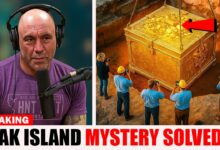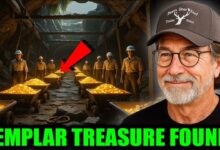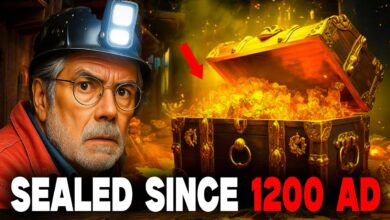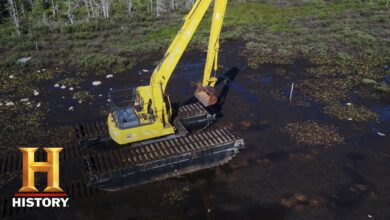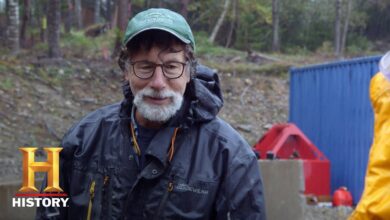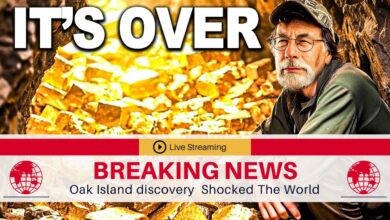Curse Of Oak Island Season 13 Episode 01: The Final Secret is Solved!
Curse Of Oak Island Season 13 Episode 01: The Final Secret is Solved!

For over 230 years, Oak Island has been a siren call to treasure hunters, a tiny speck in the North Atlantic, shrouded in legend, tragedy, and an unsolved mystery.
The story, beginning in 1795 with the discovery of a bizarre deep shaft known as the money pit, has consumed generations and claimed six lives. According to the infamous curse, one more must die before the island will relinquish its secrets.
As season 13 begins, brothers Rick and Marty Lagginina, their partner Craig Tester, and the dedicated team are more determined than ever to write the definitive chapter in the world’s longest-running treasure hunt.
The season 13 premiere, a special two-hour event, launches not with a tentative probe, but with a focused, aggressive strategy fueled by a stunning new artifact that promises to rewrite the very legend they have spent over a decade chasing.
The central thesis of this new season is elegantly simple, born from the dramatic collapses and near misses of the past. As Rick Lagginina states in the team’s opening war room meeting, the strategy is to figure out where that treasure went way deep.
The long-sought fortune, they now believe, is no longer resting in the original money pit shaft, but has fallen even further into a natural geological feature known as the solution channel, a vast water-filled cavity in the bedrock over 200 ft below the surface.
This year, the mission is to map and systematically drill this channel, a region they have explored less than 5% of, in the hopes of finding the one thing that will trigger a full-scale recovery: the Piblatto Promise, a 14th-century game changer.
The premiere’s most electrifying moment does not come from a hole in the ground, but from a presentation in the war room. Researcher Doug Craell introduces Steve Solomon, a man with a profound family connection to the island’s history.
Solomon is a descendant of the Archabald family, key players in the 19th-century treasure hunt. He has come to present what he believes is the single most important piece of physical evidence ever linked to the money pit: the object recovered in the famed Piblatto incident of 1849.
The story is Oak Island lore canon. In 1849, foreman James Piblato was conducting a drilling operation in the flooded money pit. At 98 ft, the augur passed through what was described as two wooden platforms with loose metal in between, believed to be treasure chests.
When the drill bit was retrieved, Pablato was seen pocketing a small shiny object. He later secretly approached businessman Charles Archabald, showed him the item, and the two immediately attempted to buy the eastern end of the island. Their offer was refused, and the nature of Piblatto’s find was lost to history.
Until now. Steve Solomon produces a silver coin passed down through his family directly from the Archabalds. He believes this is the very object Pablatto retrieved.
The room falls silent as Rick and Marty examine it. It’s a Portuguese torren’s deceital, and archometallurgist Emma Culligan later confirms it is genuine, dating from the reign of King Ferdinand I between 1367 and 1383.
The coin is composed of 37.5% silver, is slightly bent—a possible result of the powerful augur—and is in remarkable condition, suggesting it was sealed away for centuries. The implications are seismic.
As Charles Barkhouse notes, this is singularly unique in terms of its importance. There is a narrative associated with the coin. For the first time, the team is not just interpreting carbon dates or soil samples. They are holding a tangible piece of the treasure with a documented story linking it directly to a depth of nearly 100 ft in the money pit in 1849.
The Templar connection, a long-held theory for the team, intensifies when researcher Judy Rutabouch points out a mark on the coin that strongly resembles a Templar cross. This aligns perfectly with the team’s previous investigations into the Knights Templar and their successor order in Portugal, the Knights of Christ.
The coin becomes more than currency. It is a historical breadcrumb. Marty Lagginina captures the shift in thinking: “If this coin were 100% known to be what came out of the money pit, it’s the strongest thing we’ve ever found. This may be what lies below.”
For Rick, it is vindication. “To me, it’s proof that something is at the bottom of the money pit.”
The deep dive probing the solution channel, bolstered by the coin’s revelation, takes on new urgency. The field operations focus on boreholes J6, and later 8 and 5, drilled just 5 ft south of last season’s massive collapse in the T1 shaft.
The goal is to punch through the bedrock and into the solution channel below, searching for the debris field of treasure they believe settled there.
The drilling is a tense, meticulous process. The team, including geologist Terry Mat and operations manager Scott Barlo, watches intently as the drill bit chews through soil and rock.
A significant moment arrives when the rods suddenly drop, indicating they have broken through the ledge into the solution channel. The anticipation is palpable. They are now operating at depths of 180 to 210 ft, far beyond where any known searchers have reached.
The cores pulled from these depths are examined with an almost religious fervor. Gary Drayton’s metal detector is run over every sample. While they don’t pull up a chest of gold, they do make significant finds: chunks of thick non-corrosive metal.
Initially puzzling, these fragments are identified as pieces of old drill casing likely from the 19th century. Rather than being disappointing, this discovery is another critical clue. It suggests they are drilling through the very same searcher holes from the 1840s, meaning they are in the precise location of the original money pit.
As Mat theorizes, a searcher’s casing might still be in the ground if the driller quits and walks off the site because he found something in the eye—a direct nod to Pablatto.
The premiere concludes with the team still mapping the channel, having found slushy material, but not yet the motherlode. However, the strategy is validated: they are in the right place, drilling at the right depths, and the belief that the treasure has fallen deeper is now the central driving tenet of their entire operation.
Lot 5 is unraveling a timeline of mystery while the money pit drilling commands attention. The archaeological work on Lot 5 continues to paint a breathtakingly complex picture of the island’s hidden history.
Under the guidance of archaeologist Laird Nann, the team is excavating a mysterious rounded stone foundation and a nearby rectangular feature, both deliberately buried. The discoveries here are rapidly accumulating and predate the 1795 money pit discovery by centuries.
Metal detection expert Gary Drayton and Alex Lagginina uncover a heavy iron fastener, possibly evidence of another structure. But the most telling finds come from the careful sifting of the team. They recover a piece of Staffordshire slipware pottery dated between 1675 and 1770.
As Rick notes, finding such early material in an undocumented structure is changing Nova Scotian history. Even more compelling is the discovery of another small seed-sized Venetian glass bead by archaeologist Tanzer Reynolds. This adds to a growing collection of beads found on the site, including one made of forest glass that could date back to the 10th century.
These beads were valuable trade items and status symbols, and their presence suggests this was not a simple colonial homestead. The team has also previously found a lead barter token and buttons linked to the Knights of Malta, a direct descendant of the Templars.
Laird Nann summarizes the significance: the site shows evidence of activity from as early as 1200, a middle ground in the 14th to 16th centuries, and then the known searcher era post-1795. Lot 5 is emerging as a multigenerational base camp potentially used by different groups over hundreds of years, all possibly connected to the enigma buried in the money pit.
A unified theory of the past. The season 13 premiere masterfully weaves these three narrative threads—the Portuguese coin, the deep drilling, and the Lot 5 archaeology—into a single compelling tapestry.
The coin provides a “why” for the frantic drilling in the solution channel. The drilling provides a “where” for the treasure the team is now certain exists. And the work on Lot 5 provides a “who” and a “when,” suggesting a centuries-long clandestine effort involving medieval Europeans—potentially Templars or their affiliates—to hide something of immense value on this remote island.
The energy is different this year. The hope is no longer a vague optimism but a focused confidence. They have a map to the deep, a coin in their hands, and a timeline stretching back to the Middle Ages.
As the team embarks on this ambitious quest, Rick Lagginina’s words ring with a newfound certainty. Holding the Portuguese coin, a tangible link across centuries, he understands its true power—its proof. Proof that after 230 years, six lives lost, and countless fortunes spent, the island is finally ready to give up its deepest secrets.
The curse may not be broken yet, but for the first time, the key is firmly in their grasp.
The introduction of the Portuguese coin does more than just validate the treasure hunt. It fundamentally shifts the historical narrative the team has been piecing together for years.
The Templar theory existed in the realm of intriguing symbology and architectural parallels. The coin, however, is a datable, tangible object with a direct link to the money pit’s depths. It moves the theory from the speculative to the plausible, providing a hard metallic clue that connects the dots between medieval Portugal, the Knights of Christ, and the intricate workings deep below Oak Island.
This isn’t just a relic. It’s a piece of evidence that narrows the field of potential depositors, giving the team a specific historical era and culture to focus their research on, making the sprawling mystery suddenly feel more personal and traceable.
This renewed focus is critically important in the face of the immense technical challenge posed by the solution channel. The premiere underscores that this is not a simple digging operation. The channel is described as a moving mud river and a chaotic, unpredictable cavity.
The act of drilling into it is a high-stakes gamble, where a valuable object could be pushed aside by the drill bit or lost in the watery sludge. This geological labyrinth represents the final, most formidable adversary in the treasure hunt—a natural booby trap more effective than any man-made flood tunnel. Success will require not just brute force, but delicate and strategic probing. A game of three-dimensional chess played blind in the Earth’s basement.
Simultaneously, the archaeological work on Lot 5 is evolving from a mere artifact recovery mission into a full-scale historical investigation. Each finding—the slipware, the beads, the iron fasteners—is a sentence in a story the team is only beginning to read.
The rounded foundation is no longer just a ruin. It is a potential command center, a safe house for those who guarded the secret. The variety and age of the artifacts suggest that Oak Island was not a one-time deposit site, but a recurring port of call for a specific secretive group over centuries.
This transforms the treasure hunt from a search for a static chest into an investigation of a living, breathing historical operation of monumental ambition and secrecy.
The human element remains the show’s compelling core, and the premiere highlights the distinct philosophies of the Lagginina brothers. Rick, the eternal optimist, is visibly moved by the coin, seeing it as the spiritual confirmation he has long sought. Marty, the pragmatic engineer, processes the same object through a lens of probability and strategy, asking, “Is it 51% likely or better?”
This dynamic is the engine of the hunt. Rick’s passion provides the unwavering drive, while Marty’s skepticism ensures the drive is channeled into logical, effective action. Their partnership embodies the very balance between faith and reason required to tackle a legend as entrenched as Oak Island’s.
As the team moves forward, the path is clear but fraught with uncertainty. The drilling program will expand, systematically grid-searching the solution channel in the hopes of a definitive bank vault hit.
The archaeology on Lot 5 will continue to peel back the layers, potentially uncovering the structural remains that could definitively identify its inhabitants. And the research ignited by the Portuguese coin will now delve deeper into the financial and maritime records of 14th-century Portugal and the Knights of Christ, searching for a document that mentions a transatlantic voyage to a remote island.
The season 13 premiere masterfully sets the stage for what could be the story’s final act. It provides the team and the audience with the strongest evidence yet that the treasure is not only real but within reach. They have the key artifact, the refined geological theory, and the expanding historical context.
The pieces of the puzzle are now on the table. The monumental task that remains is to assemble them to finally answer the questions that have echoed for over two centuries: what lies in the abyss of the solution channel, and who, all those years ago, went to such extraordinary lengths to put it there?
The hunt, deeper and more focused than ever, has truly begun. [Laughter]
